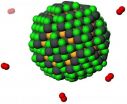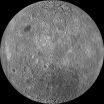(Press-News.org) A group of scientists believe that a previously unexplained isotopic ratio from deep within the Earth may be a signal from material from the time before the Earth collided with another planet-sized body, leading to the creation of the Moon. This may represent the echoes of the ancient Earth, which existed prior to the proposed collision 4.5 billion years ago. This work is being presented at the Goldschmidt conference in Sacramento, California.
The currently favoured theory says that the Moon was formed 4.5 billion years ago, when the Earth collided with a Mars-sized mass, which has been given the name "Theia". According to this theory, the heat generated by the collision would have caused the whole planet to melt, before some of the debris cooled and spun off to create the Moon.
Now however, a group of scientists from Harvard University believe that they have identified a sign that only part of the Earth melted, and that an ancient part still exists within the Earth's mantle.
According to lead researcher Associate Professor Sujoy Mukhopadhyay (Harvard):
"The energy released by the impact between the Earth and Theia would have been huge, certainly enough to melt the whole planet. But we believe that the impact energy was not evenly distributed throughout the ancient Earth. This means that a major part of the impacted hemisphere would probably have been completely vaporised, but the opposite hemisphere would have been partly shielded, and would not have undergone complete melting".
The team has analysed the ratios of noble gas isotopes from deep within the Earth's mantle, and has compared these results to isotope ratios closer to the surface. The found that 3He to 22Ne ratio from the shallow mantle is significantly higher than the equivalent ratio in the deep mantle.
Professor Mukhopadhyay commented, "This implies that the last giant impact did not completely mix the mantle and there was not a whole mantle magma ocean".
Additional evidence comes from analysis of the 129-Xenon to 130-Xenon ratio. It is known that material brought to the surface from the deep mantle (via mantle plumes) has a lower ratio than that normally found nearer the surface, for example in the basalts from mid-ocean ridges. Since 129-Xenon is produced by radioactive decay of 129-Iodine, these xenon isotopes put a time stamp on the formation age of the ancient parcel of mantle to within the first 100 million years of Earth's history.
Professor Mukhopadhyay continued "The geochemistry indicates that there are differences between the noble gas isotope ratios in different parts of the Earth, and these need to be explained. The idea that a very disruptive collision of the Earth with another planet-sized body, the biggest event in Earth's geological history, did not completely melt and homogenize the Earth challenges some of our notions on planet formation and the energetics of giant impacts. If the theory is proven correct, then we may be seeing echoes of the ancient Earth, from a time before the collision".
Commenting, Professor Richard Carlson (Carnegie Institute of Washington), Past President of the Geochemical Society said:
"This exciting result is adding to the observational evidence that important aspects of Earth's composition were established during the violent birth of the planet and is providing a new look at the physical processes by which this can occur".
INFORMATION:
Notes for Editors
For more information, please contact:
Professor Sujoy Mukhopadhyay
sujoy@eps.harvard.edu
Professor Richard Carlson
rcarlson@ciw.edu
Goldschmidt Press Officer, Tom Parkhill
tom@parkhill.it
tel +44 131 208 3008 (Central European Summer Time Zone).
Dr. Sujoy Mukhopadhyay will present "Chemical heterogeneities survive giant impacts and mantle convection" to the Goldschmidt conference, Sacramento, California, on Monday 9th June at 08.30 Eastern Time. The Goldschmidt conference is the world's leading annual conference on geochemistry, http://goldschmidt.info/2014/
Please mention the Goldschmidt conference in any story which results from this press release.
ABSTRACT
Chemical heterogeneities survive giant impacts and mantle convection
S. MUKHOPADHYAY, S.T. STEWART, J. M. TUCKER, R. PARAI AND , S. LOCK
Dept. of Earth & Planetary Sciences, Harvard University,
Cambridge, MA 02138, USA
The giant impact phase of Earth's accretion likely produced multiple magma oceans. In particular, the Moon-forming giant impact is often thought to have produced a whole mantle magma ocean, which should have erased pre-existing chemical heterogeneities within the Earth. We argue that the ratio of 3He to 22Ne in the present day mantle does record multiple magma ocean episodes during Earth's accretion. However, the 3He/22Ne ratio of the Earth's shallow depleted mantle is significantly higher than the deep mantle indicating that the last giant impact did not generate a whole mantle magma ocean. Although the energy associated with the Moon-forming giant impact was sufficient to melt the whole planet, the impact energy is heterogeneously deposited; the impacted hemisphere is shocked to the point of partial vaporization, but the opposite hemisphere experiences modest heating that does not result in completely melting. As a result, chemical heterogeneities persist through the giant impact phase of accretion.
Additional evidence for the preservation of early-formed heterogeneities in the deep mantle is provided by 129Xe/130Xe ratios. Deep mantle plumes have a lower ratio of 129Xe/130Xe compared to the source of mid-ocean ridge basalts (MORBs). The Xe signature requires a region of the deep mantle to be less degassed and to have separated from the shallower MORB source by 4.45 Ga (since 129I, which produces 129Xe, is extinct after ~100 Ma); i.e., neither the giant impact phase nor mantle convection has efficiently homogenized the mantle. The persistence of noble gas signatures produced very early in Earth history, such as those associated with the 129I-129Xe system, may appear to be in conflict with other extinct nuclide systems such as 146Sm-142Nd or 182Hf-182W. While isotopic anomalies in ε142Nd and ε182W are present in the Hadean and Archean mantle, the present-day mantle appears to be homogeneous. The observation requires Sm-Nd and Hf-W fractionation within the first few hundred Ma but also the subsequent destruction of the chemical fractionation through recycling and mantle mixing. A simple explanation for why the noble gas signature still persists in the present-day mantle may be the lower recycling efficiency of the noble gases compared to elements like Nd and W.
Scientists may have identified echoes of ancient Earth
2014-06-09
ELSE PRESS RELEASES FROM THIS DATE:
Surgery prices are elusive
2014-06-09
Let's say you're buying a car. You have a wealth of data at your fingertips, from safety information to performance, to guide your decision.
The same is not as true in health care, especially if you're pricing procedures. A new study from the University of Iowa compared the cost of prostate cancer surgery at 100 hospitals throughout the United States. The quote for the procedure, the researchers found, varied from $10,100 to $135,000, a 13-fold range. (The average price was nearly $35,000, more than double the Medicare reimbursement.)
Only 10 of the hospitals that provided ...
New class of nanoparticle brings cheaper, lighter solar cells outdoors
2014-06-09
TORONTO, ON — Think those flat, glassy solar panels on your neighbour's roof are the pinnacle of solar technology? Think again.
Researchers in the University of Toronto's Edward S. Rogers Sr. Department of Electrical & Computer Engineering have designed and tested a new class of solar-sensitive nanoparticle that outshines the current state of the art employing this new class of technology.
This new form of solid, stable light-sensitive nanoparticles, called colloidal quantum dots, could lead to cheaper and more flexible solar cells, as well as better gas sensors, infrared ...
With distance comes greater wisdom, research finds
2014-06-09
If you're faced with a troubling personal dilemma, such as a cheating spouse, you are more likely to think wisely about it if you consider it as an observer would, says a study led by a professor at the University of Waterloo.
Professor Igor Grossmann, of Waterloo, and Professor Ethan Kross from the University of Michigan, asked study participants to reflect on a relationship conflict of their own or someone else's, such as a spouse's infidelity with a close friend, and think about the conflict in the first and third person. The findings will appear in an upcoming issue ...
Online marketing schemes can still lure in customers
2014-06-09
Despite warnings and legislation, online consumers may still be susceptible to post-transaction marketing schemes, according to Penn State researchers.
At least 40 percent of consumers who made an online purchase in a study bought an additional product, even though it offered no extra value, said Jens Grossklags, assistant professor of information sciences and technology.
"The focus of this study was to determine the likelihood that a consumer would accept an offer after they had already made a purchase," said Grossklags. "What stood out was the vast number of people ...
Seeing how a lithium-ion battery works
2014-06-09
CAMBRIDGE, Mass-- New observations by researchers at MIT have revealed the inner workings of a type of electrode widely used in lithium-ion batteries. The new findings explain the unexpectedly high power and long cycle life of such batteries, the researchers say.
The findings appear in a paper in the journal Nano Letters co-authored by MIT postdoc Jun Jie Niu, research scientist Akihiro Kushima, professors Yet-Ming Chiang and Ju Li, and three others.
The electrode material studied, lithium iron phosphate (LiFePO4), is considered an especially promising material for ...
Science and technology advances in microbial forensics needed to better prepare
2014-06-09
WASHINGTON – Much as human DNA can be used as evidence in criminal trials, genetic information about microorganisms can be analyzed to identify pathogens or other biological agents in the event of a suspicious disease outbreak. The tools and methods used to investigate such outbreaks belong to an emerging discipline known as microbial forensics, but the field faces substantial scientific and technical challenges, says a new report from the National Research Council. The report offers an initial set of research priorities for advancing the capabilities needed to make microbial ...
Specific protein may help beta cells survive in type 1 diabetes
2014-06-09
In the healthy pancreas of someone without type 1 diabetes (T1D), the hormone insulin (essential for turning food into energy) is produced, stored, and released in a normal "factory-like" process within pancreatic beta cells in response to glucose in the diet. Early in the course of T1D, however, excessive or pathologic stress in beta cells compromises their ability to properly secrete insulin, triggering a cascade of events ultimately contributing to the beta cell death. Over the past several years, JDRF-funded researchers have found evidence that beta cell stress may ...
55-year old dark side of the moon mystery solved
2014-06-09
The Man in the Moon appeared when meteoroids struck the Earth-facing side of the moon creating large flat seas of basalt that we see as dark areas called maria. But no "face" exists on farside of the moon and now, Penn State astrophysicists think they know why.
"I remember the first time I saw a globe of the moon as a boy, being struck by how different the farside looks," said Jason Wright, assistant professor of astrophysics. "It was all mountains and craters. Where were the maria? It turns out it's been a mystery since the fifties."
This mystery is called the Lunar ...
Tangled path of Alzheimer's-linked brain cells mapped in mice
2014-06-09
By studying laboratory mice, scientists at The Johns Hopkins University have succeeded in plotting the labyrinthine paths of some of the largest nerve cells in the mammalian brain: cholinergic neurons, the first cells to degenerate in people with Alzheimer's disease.
"For us, this was like scaling Mount Everest," says Jeremy Nathans, Ph.D., professor of molecular biology and genetics, neuroscience, and ophthalmology at the Johns Hopkins University School of Medicine. "This work reveals the amazing challenges that cholinergic neurons face every day. Each of these cells ...
NASA's TRMM satellite analyzes Mexico's soaking tropical rains
2014-06-09
VIDEO:
This movie of NOAA's GOES-East satellite imagery shows the movement of System 90L over land and dissipating between June 6 and June 7 at 2000 UTC (4 p.m. EDT)....
Click here for more information.
The movement of tropical storm Boris into southern Mexico and a nearly stationary low pressure system in the southern Gulf of Mexico caused heavy rainfall in that area. NASA and the Japan Aerospace Exploration Agency's Tropical Rainfall Measuring Mission satellite known as TRMM ...




